Cultural Analysis of Australia for International Business Expansion
VerifiedAdded on 2020/05/04
|11
|3245
|248
Report
AI Summary
This report provides a comprehensive cultural analysis of Australia, focusing on its suitability for international business operations. It begins with a rationale for selecting Australia, highlighting its multicultural environment, innovative business culture, and direct communication style. The report then delves into the country's political, social, and economic situation, local culture, and communication practices, emphasizing the importance of directness and non-verbal cues in business interactions. It also examines the Australian management style, which is consultative and consensus-oriented. A detailed comparison of the business cultures of Australia and Singapore is presented, along with an analysis using Hofstede's cultural dimensions to assess cultural fit for business operations. The report further explores strategies employed by foreign companies in Australia and concludes with a summary of key findings.
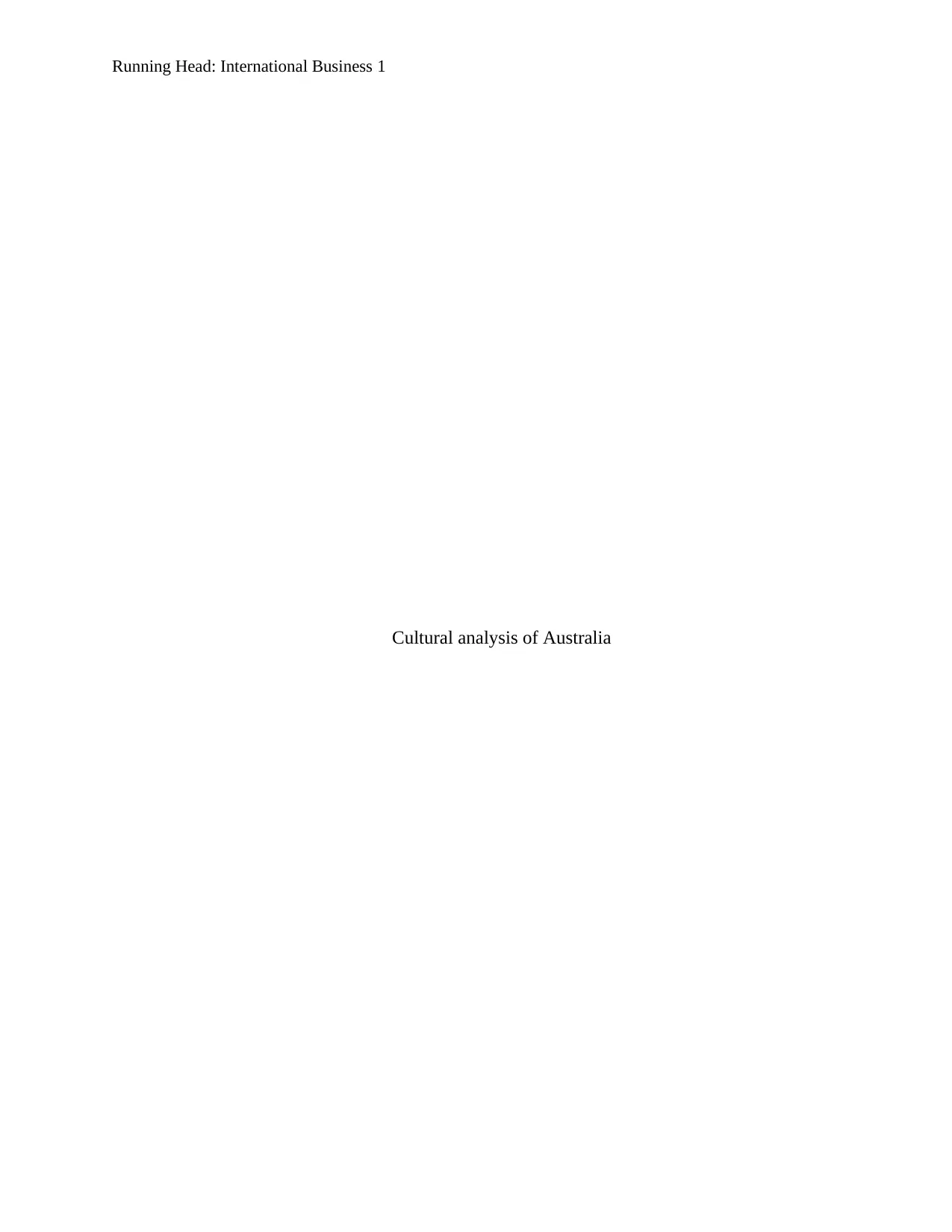
Running Head: International Business 1
Cultural analysis of Australia
Cultural analysis of Australia
Paraphrase This Document
Need a fresh take? Get an instant paraphrase of this document with our AI Paraphraser
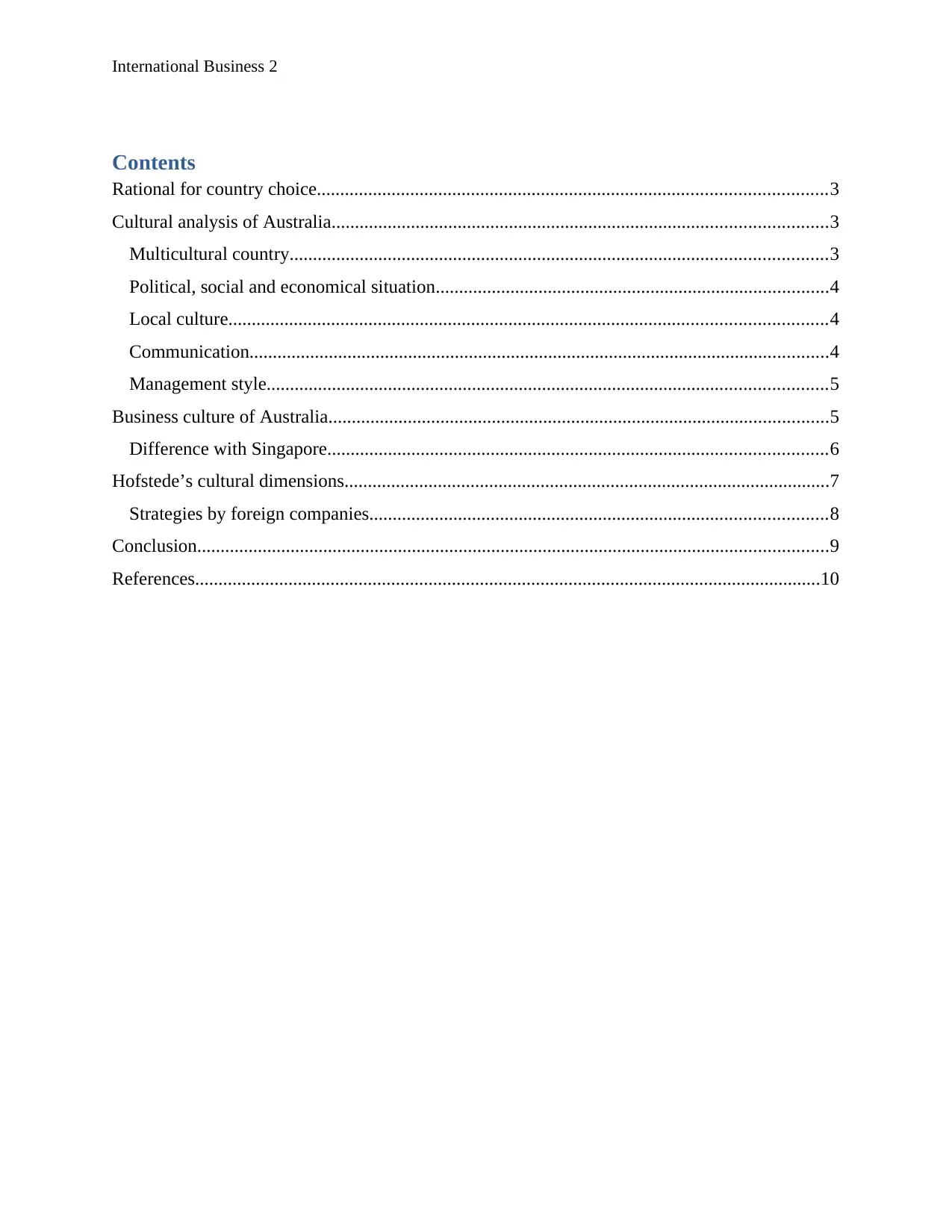
International Business 2
Contents
Rational for country choice.............................................................................................................3
Cultural analysis of Australia..........................................................................................................3
Multicultural country...................................................................................................................3
Political, social and economical situation....................................................................................4
Local culture................................................................................................................................4
Communication............................................................................................................................4
Management style........................................................................................................................5
Business culture of Australia...........................................................................................................5
Difference with Singapore...........................................................................................................6
Hofstede’s cultural dimensions........................................................................................................7
Strategies by foreign companies..................................................................................................8
Conclusion.......................................................................................................................................9
References......................................................................................................................................10
Contents
Rational for country choice.............................................................................................................3
Cultural analysis of Australia..........................................................................................................3
Multicultural country...................................................................................................................3
Political, social and economical situation....................................................................................4
Local culture................................................................................................................................4
Communication............................................................................................................................4
Management style........................................................................................................................5
Business culture of Australia...........................................................................................................5
Difference with Singapore...........................................................................................................6
Hofstede’s cultural dimensions........................................................................................................7
Strategies by foreign companies..................................................................................................8
Conclusion.......................................................................................................................................9
References......................................................................................................................................10
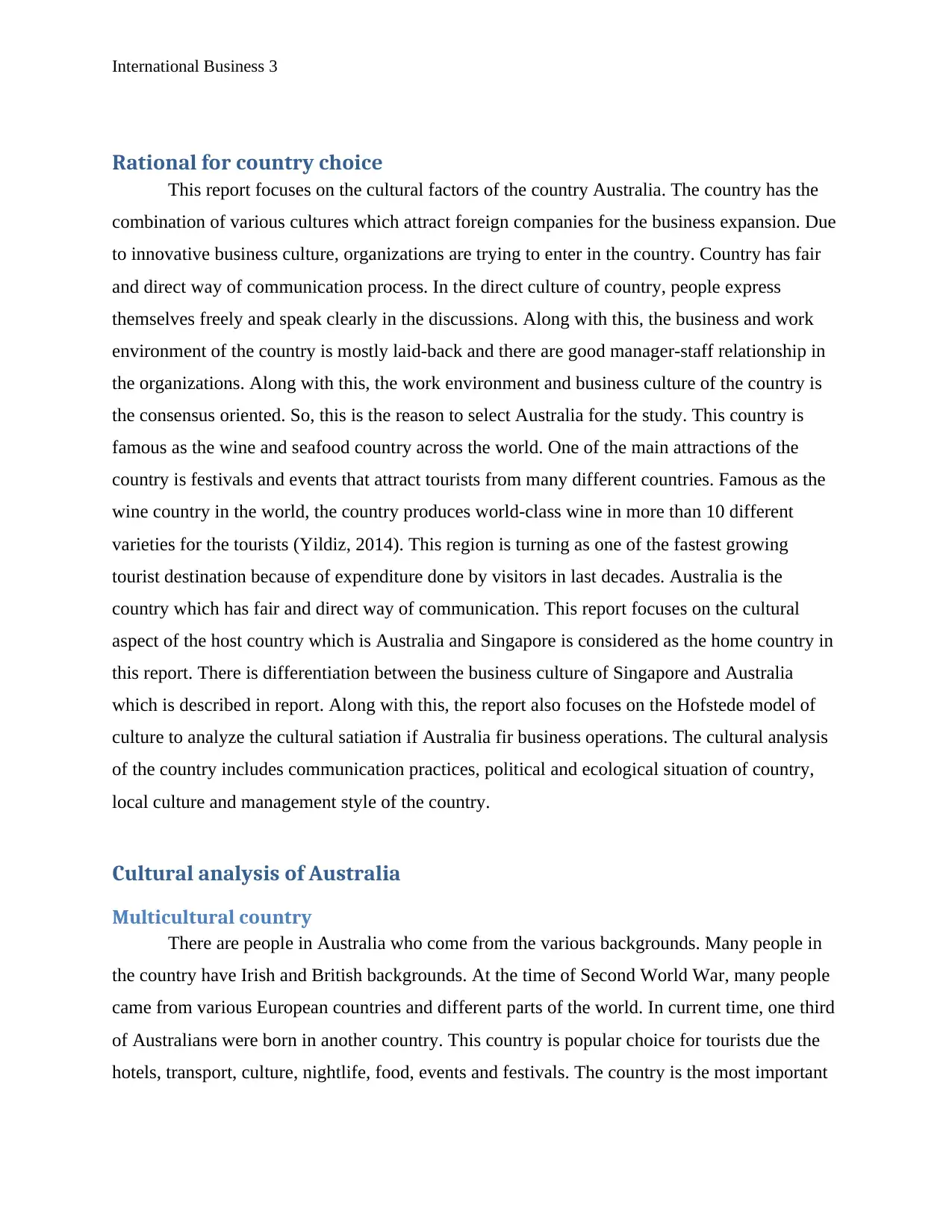
International Business 3
Rational for country choice
This report focuses on the cultural factors of the country Australia. The country has the
combination of various cultures which attract foreign companies for the business expansion. Due
to innovative business culture, organizations are trying to enter in the country. Country has fair
and direct way of communication process. In the direct culture of country, people express
themselves freely and speak clearly in the discussions. Along with this, the business and work
environment of the country is mostly laid-back and there are good manager-staff relationship in
the organizations. Along with this, the work environment and business culture of the country is
the consensus oriented. So, this is the reason to select Australia for the study. This country is
famous as the wine and seafood country across the world. One of the main attractions of the
country is festivals and events that attract tourists from many different countries. Famous as the
wine country in the world, the country produces world-class wine in more than 10 different
varieties for the tourists (Yildiz, 2014). This region is turning as one of the fastest growing
tourist destination because of expenditure done by visitors in last decades. Australia is the
country which has fair and direct way of communication. This report focuses on the cultural
aspect of the host country which is Australia and Singapore is considered as the home country in
this report. There is differentiation between the business culture of Singapore and Australia
which is described in report. Along with this, the report also focuses on the Hofstede model of
culture to analyze the cultural satiation if Australia fir business operations. The cultural analysis
of the country includes communication practices, political and ecological situation of country,
local culture and management style of the country.
Cultural analysis of Australia
Multicultural country
There are people in Australia who come from the various backgrounds. Many people in
the country have Irish and British backgrounds. At the time of Second World War, many people
came from various European countries and different parts of the world. In current time, one third
of Australians were born in another country. This country is popular choice for tourists due the
hotels, transport, culture, nightlife, food, events and festivals. The country is the most important
Rational for country choice
This report focuses on the cultural factors of the country Australia. The country has the
combination of various cultures which attract foreign companies for the business expansion. Due
to innovative business culture, organizations are trying to enter in the country. Country has fair
and direct way of communication process. In the direct culture of country, people express
themselves freely and speak clearly in the discussions. Along with this, the business and work
environment of the country is mostly laid-back and there are good manager-staff relationship in
the organizations. Along with this, the work environment and business culture of the country is
the consensus oriented. So, this is the reason to select Australia for the study. This country is
famous as the wine and seafood country across the world. One of the main attractions of the
country is festivals and events that attract tourists from many different countries. Famous as the
wine country in the world, the country produces world-class wine in more than 10 different
varieties for the tourists (Yildiz, 2014). This region is turning as one of the fastest growing
tourist destination because of expenditure done by visitors in last decades. Australia is the
country which has fair and direct way of communication. This report focuses on the cultural
aspect of the host country which is Australia and Singapore is considered as the home country in
this report. There is differentiation between the business culture of Singapore and Australia
which is described in report. Along with this, the report also focuses on the Hofstede model of
culture to analyze the cultural satiation if Australia fir business operations. The cultural analysis
of the country includes communication practices, political and ecological situation of country,
local culture and management style of the country.
Cultural analysis of Australia
Multicultural country
There are people in Australia who come from the various backgrounds. Many people in
the country have Irish and British backgrounds. At the time of Second World War, many people
came from various European countries and different parts of the world. In current time, one third
of Australians were born in another country. This country is popular choice for tourists due the
hotels, transport, culture, nightlife, food, events and festivals. The country is the most important
⊘ This is a preview!⊘
Do you want full access?
Subscribe today to unlock all pages.

Trusted by 1+ million students worldwide
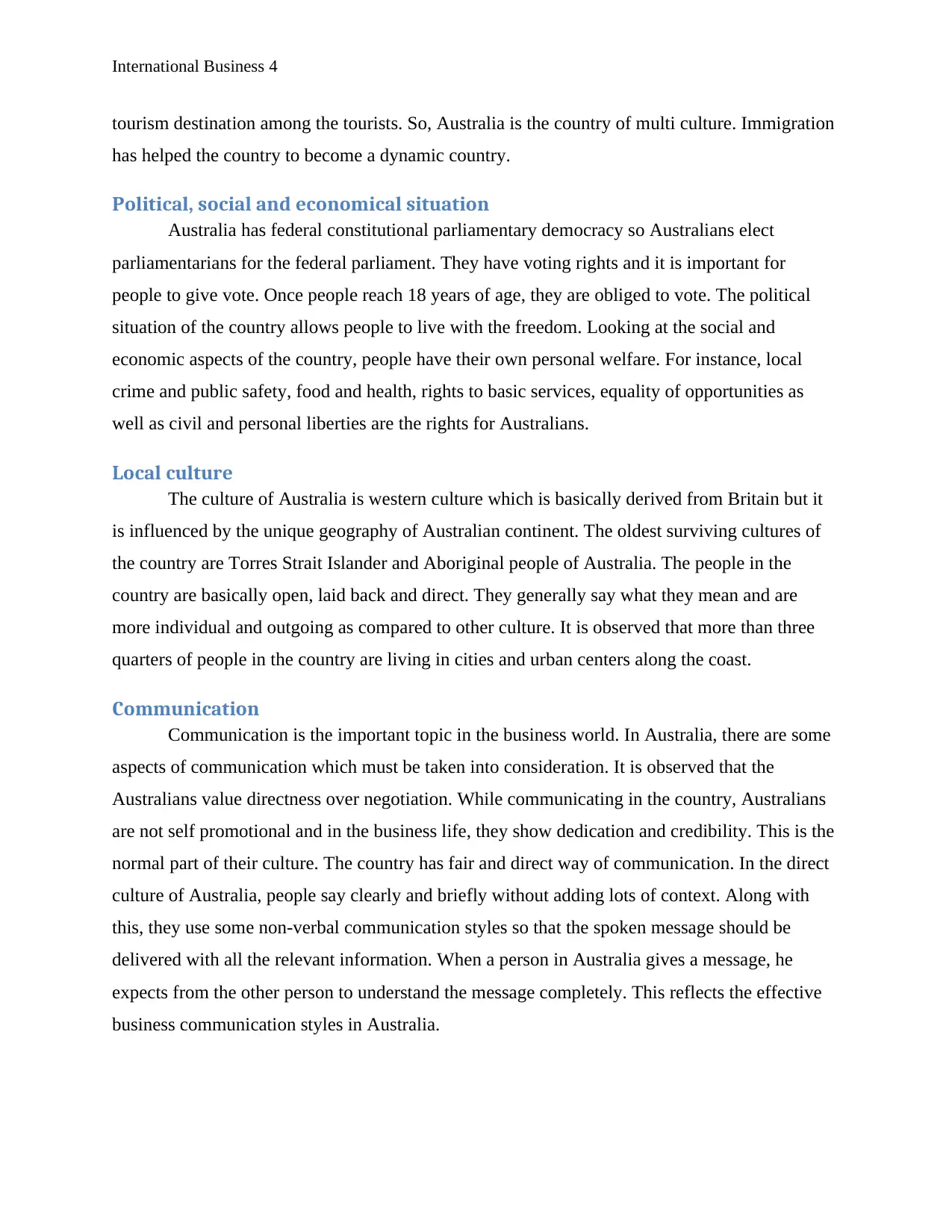
International Business 4
tourism destination among the tourists. So, Australia is the country of multi culture. Immigration
has helped the country to become a dynamic country.
Political, social and economical situation
Australia has federal constitutional parliamentary democracy so Australians elect
parliamentarians for the federal parliament. They have voting rights and it is important for
people to give vote. Once people reach 18 years of age, they are obliged to vote. The political
situation of the country allows people to live with the freedom. Looking at the social and
economic aspects of the country, people have their own personal welfare. For instance, local
crime and public safety, food and health, rights to basic services, equality of opportunities as
well as civil and personal liberties are the rights for Australians.
Local culture
The culture of Australia is western culture which is basically derived from Britain but it
is influenced by the unique geography of Australian continent. The oldest surviving cultures of
the country are Torres Strait Islander and Aboriginal people of Australia. The people in the
country are basically open, laid back and direct. They generally say what they mean and are
more individual and outgoing as compared to other culture. It is observed that more than three
quarters of people in the country are living in cities and urban centers along the coast.
Communication
Communication is the important topic in the business world. In Australia, there are some
aspects of communication which must be taken into consideration. It is observed that the
Australians value directness over negotiation. While communicating in the country, Australians
are not self promotional and in the business life, they show dedication and credibility. This is the
normal part of their culture. The country has fair and direct way of communication. In the direct
culture of Australia, people say clearly and briefly without adding lots of context. Along with
this, they use some non-verbal communication styles so that the spoken message should be
delivered with all the relevant information. When a person in Australia gives a message, he
expects from the other person to understand the message completely. This reflects the effective
business communication styles in Australia.
tourism destination among the tourists. So, Australia is the country of multi culture. Immigration
has helped the country to become a dynamic country.
Political, social and economical situation
Australia has federal constitutional parliamentary democracy so Australians elect
parliamentarians for the federal parliament. They have voting rights and it is important for
people to give vote. Once people reach 18 years of age, they are obliged to vote. The political
situation of the country allows people to live with the freedom. Looking at the social and
economic aspects of the country, people have their own personal welfare. For instance, local
crime and public safety, food and health, rights to basic services, equality of opportunities as
well as civil and personal liberties are the rights for Australians.
Local culture
The culture of Australia is western culture which is basically derived from Britain but it
is influenced by the unique geography of Australian continent. The oldest surviving cultures of
the country are Torres Strait Islander and Aboriginal people of Australia. The people in the
country are basically open, laid back and direct. They generally say what they mean and are
more individual and outgoing as compared to other culture. It is observed that more than three
quarters of people in the country are living in cities and urban centers along the coast.
Communication
Communication is the important topic in the business world. In Australia, there are some
aspects of communication which must be taken into consideration. It is observed that the
Australians value directness over negotiation. While communicating in the country, Australians
are not self promotional and in the business life, they show dedication and credibility. This is the
normal part of their culture. The country has fair and direct way of communication. In the direct
culture of Australia, people say clearly and briefly without adding lots of context. Along with
this, they use some non-verbal communication styles so that the spoken message should be
delivered with all the relevant information. When a person in Australia gives a message, he
expects from the other person to understand the message completely. This reflects the effective
business communication styles in Australia.
Paraphrase This Document
Need a fresh take? Get an instant paraphrase of this document with our AI Paraphraser
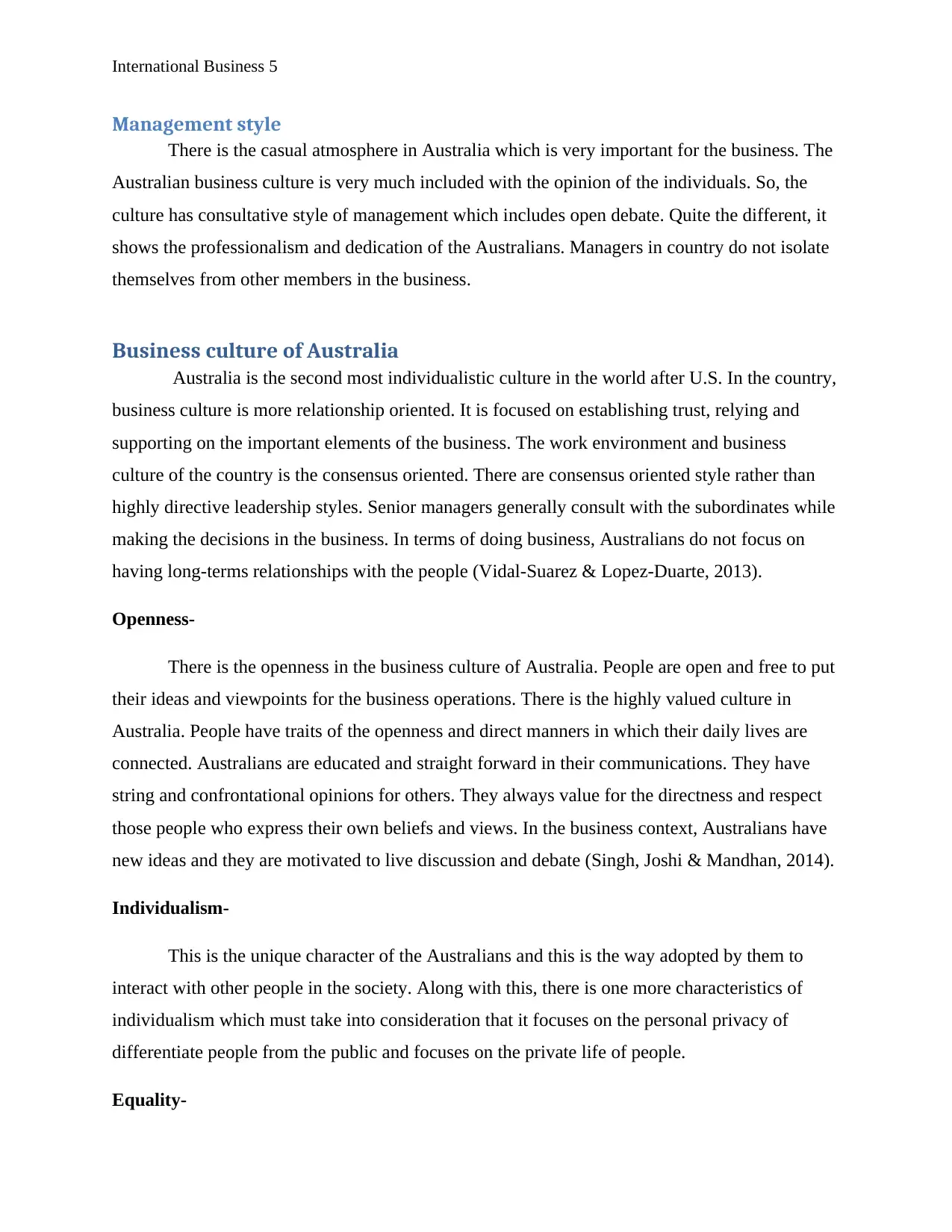
International Business 5
Management style
There is the casual atmosphere in Australia which is very important for the business. The
Australian business culture is very much included with the opinion of the individuals. So, the
culture has consultative style of management which includes open debate. Quite the different, it
shows the professionalism and dedication of the Australians. Managers in country do not isolate
themselves from other members in the business.
Business culture of Australia
Australia is the second most individualistic culture in the world after U.S. In the country,
business culture is more relationship oriented. It is focused on establishing trust, relying and
supporting on the important elements of the business. The work environment and business
culture of the country is the consensus oriented. There are consensus oriented style rather than
highly directive leadership styles. Senior managers generally consult with the subordinates while
making the decisions in the business. In terms of doing business, Australians do not focus on
having long-terms relationships with the people (Vidal-Suarez & Lopez-Duarte, 2013).
Openness-
There is the openness in the business culture of Australia. People are open and free to put
their ideas and viewpoints for the business operations. There is the highly valued culture in
Australia. People have traits of the openness and direct manners in which their daily lives are
connected. Australians are educated and straight forward in their communications. They have
string and confrontational opinions for others. They always value for the directness and respect
those people who express their own beliefs and views. In the business context, Australians have
new ideas and they are motivated to live discussion and debate (Singh, Joshi & Mandhan, 2014).
Individualism-
This is the unique character of the Australians and this is the way adopted by them to
interact with other people in the society. Along with this, there is one more characteristics of
individualism which must take into consideration that it focuses on the personal privacy of
differentiate people from the public and focuses on the private life of people.
Equality-
Management style
There is the casual atmosphere in Australia which is very important for the business. The
Australian business culture is very much included with the opinion of the individuals. So, the
culture has consultative style of management which includes open debate. Quite the different, it
shows the professionalism and dedication of the Australians. Managers in country do not isolate
themselves from other members in the business.
Business culture of Australia
Australia is the second most individualistic culture in the world after U.S. In the country,
business culture is more relationship oriented. It is focused on establishing trust, relying and
supporting on the important elements of the business. The work environment and business
culture of the country is the consensus oriented. There are consensus oriented style rather than
highly directive leadership styles. Senior managers generally consult with the subordinates while
making the decisions in the business. In terms of doing business, Australians do not focus on
having long-terms relationships with the people (Vidal-Suarez & Lopez-Duarte, 2013).
Openness-
There is the openness in the business culture of Australia. People are open and free to put
their ideas and viewpoints for the business operations. There is the highly valued culture in
Australia. People have traits of the openness and direct manners in which their daily lives are
connected. Australians are educated and straight forward in their communications. They have
string and confrontational opinions for others. They always value for the directness and respect
those people who express their own beliefs and views. In the business context, Australians have
new ideas and they are motivated to live discussion and debate (Singh, Joshi & Mandhan, 2014).
Individualism-
This is the unique character of the Australians and this is the way adopted by them to
interact with other people in the society. Along with this, there is one more characteristics of
individualism which must take into consideration that it focuses on the personal privacy of
differentiate people from the public and focuses on the private life of people.
Equality-
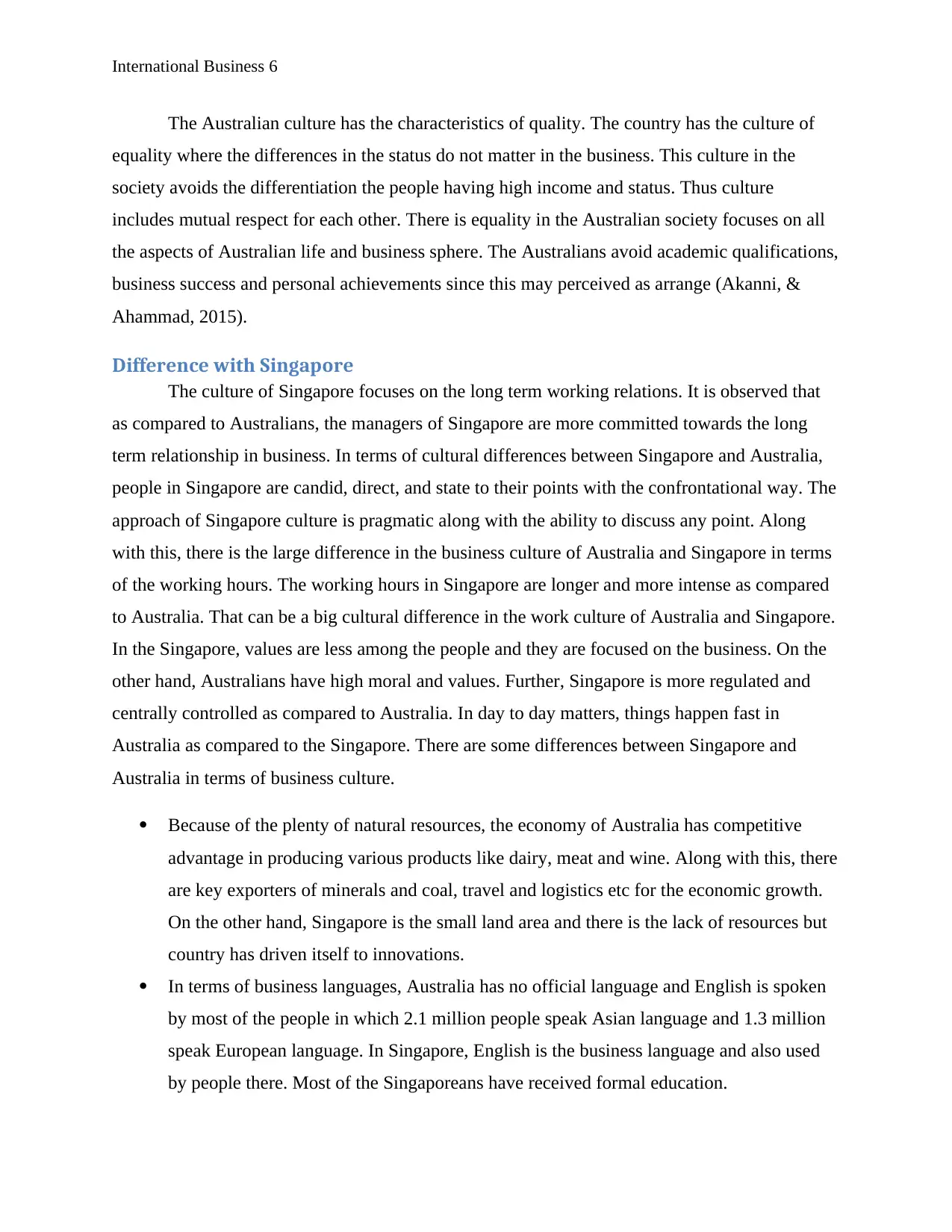
International Business 6
The Australian culture has the characteristics of quality. The country has the culture of
equality where the differences in the status do not matter in the business. This culture in the
society avoids the differentiation the people having high income and status. Thus culture
includes mutual respect for each other. There is equality in the Australian society focuses on all
the aspects of Australian life and business sphere. The Australians avoid academic qualifications,
business success and personal achievements since this may perceived as arrange (Akanni, &
Ahammad, 2015).
Difference with Singapore
The culture of Singapore focuses on the long term working relations. It is observed that
as compared to Australians, the managers of Singapore are more committed towards the long
term relationship in business. In terms of cultural differences between Singapore and Australia,
people in Singapore are candid, direct, and state to their points with the confrontational way. The
approach of Singapore culture is pragmatic along with the ability to discuss any point. Along
with this, there is the large difference in the business culture of Australia and Singapore in terms
of the working hours. The working hours in Singapore are longer and more intense as compared
to Australia. That can be a big cultural difference in the work culture of Australia and Singapore.
In the Singapore, values are less among the people and they are focused on the business. On the
other hand, Australians have high moral and values. Further, Singapore is more regulated and
centrally controlled as compared to Australia. In day to day matters, things happen fast in
Australia as compared to the Singapore. There are some differences between Singapore and
Australia in terms of business culture.
Because of the plenty of natural resources, the economy of Australia has competitive
advantage in producing various products like dairy, meat and wine. Along with this, there
are key exporters of minerals and coal, travel and logistics etc for the economic growth.
On the other hand, Singapore is the small land area and there is the lack of resources but
country has driven itself to innovations.
In terms of business languages, Australia has no official language and English is spoken
by most of the people in which 2.1 million people speak Asian language and 1.3 million
speak European language. In Singapore, English is the business language and also used
by people there. Most of the Singaporeans have received formal education.
The Australian culture has the characteristics of quality. The country has the culture of
equality where the differences in the status do not matter in the business. This culture in the
society avoids the differentiation the people having high income and status. Thus culture
includes mutual respect for each other. There is equality in the Australian society focuses on all
the aspects of Australian life and business sphere. The Australians avoid academic qualifications,
business success and personal achievements since this may perceived as arrange (Akanni, &
Ahammad, 2015).
Difference with Singapore
The culture of Singapore focuses on the long term working relations. It is observed that
as compared to Australians, the managers of Singapore are more committed towards the long
term relationship in business. In terms of cultural differences between Singapore and Australia,
people in Singapore are candid, direct, and state to their points with the confrontational way. The
approach of Singapore culture is pragmatic along with the ability to discuss any point. Along
with this, there is the large difference in the business culture of Australia and Singapore in terms
of the working hours. The working hours in Singapore are longer and more intense as compared
to Australia. That can be a big cultural difference in the work culture of Australia and Singapore.
In the Singapore, values are less among the people and they are focused on the business. On the
other hand, Australians have high moral and values. Further, Singapore is more regulated and
centrally controlled as compared to Australia. In day to day matters, things happen fast in
Australia as compared to the Singapore. There are some differences between Singapore and
Australia in terms of business culture.
Because of the plenty of natural resources, the economy of Australia has competitive
advantage in producing various products like dairy, meat and wine. Along with this, there
are key exporters of minerals and coal, travel and logistics etc for the economic growth.
On the other hand, Singapore is the small land area and there is the lack of resources but
country has driven itself to innovations.
In terms of business languages, Australia has no official language and English is spoken
by most of the people in which 2.1 million people speak Asian language and 1.3 million
speak European language. In Singapore, English is the business language and also used
by people there. Most of the Singaporeans have received formal education.
⊘ This is a preview!⊘
Do you want full access?
Subscribe today to unlock all pages.

Trusted by 1+ million students worldwide
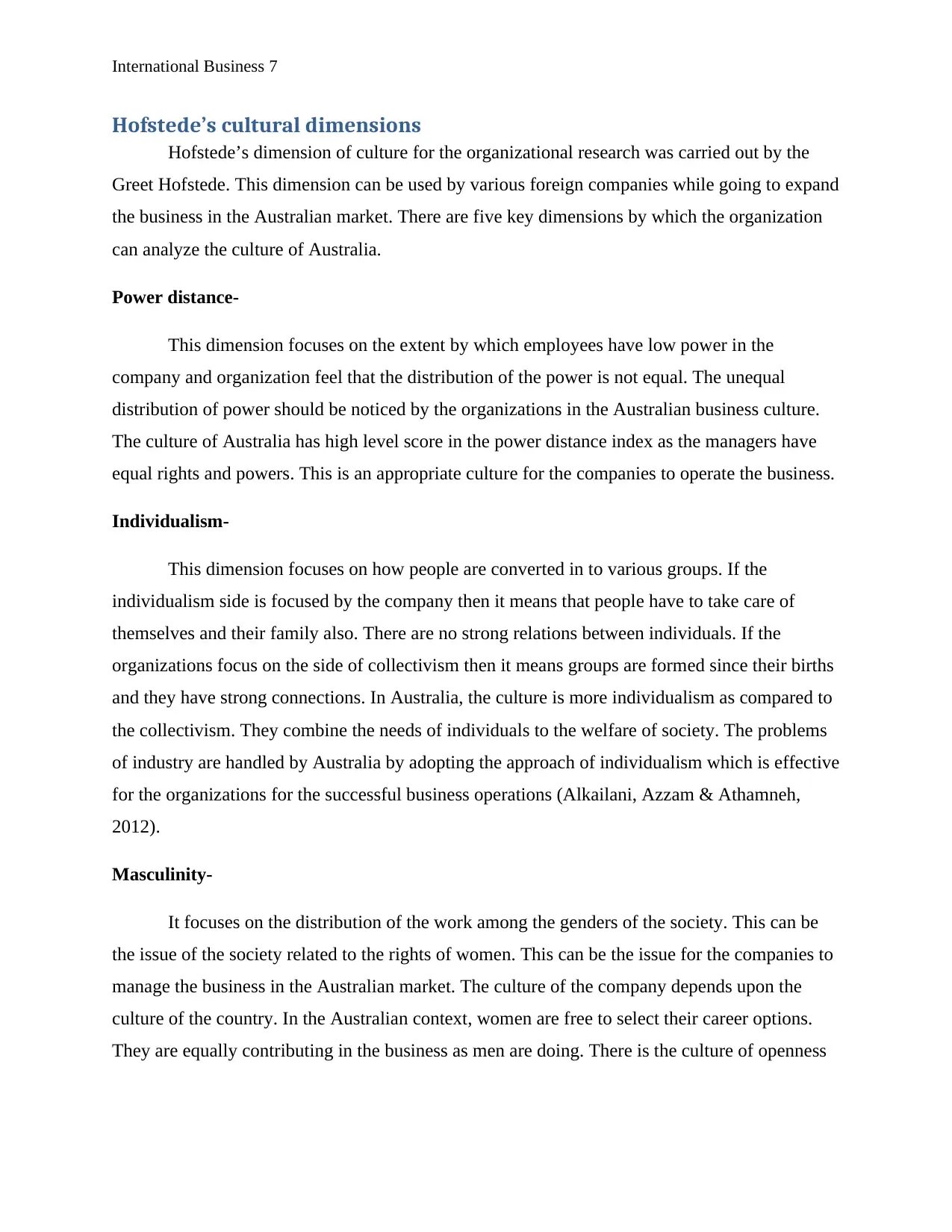
International Business 7
Hofstede’s cultural dimensions
Hofstede’s dimension of culture for the organizational research was carried out by the
Greet Hofstede. This dimension can be used by various foreign companies while going to expand
the business in the Australian market. There are five key dimensions by which the organization
can analyze the culture of Australia.
Power distance-
This dimension focuses on the extent by which employees have low power in the
company and organization feel that the distribution of the power is not equal. The unequal
distribution of power should be noticed by the organizations in the Australian business culture.
The culture of Australia has high level score in the power distance index as the managers have
equal rights and powers. This is an appropriate culture for the companies to operate the business.
Individualism-
This dimension focuses on how people are converted in to various groups. If the
individualism side is focused by the company then it means that people have to take care of
themselves and their family also. There are no strong relations between individuals. If the
organizations focus on the side of collectivism then it means groups are formed since their births
and they have strong connections. In Australia, the culture is more individualism as compared to
the collectivism. They combine the needs of individuals to the welfare of society. The problems
of industry are handled by Australia by adopting the approach of individualism which is effective
for the organizations for the successful business operations (Alkailani, Azzam & Athamneh,
2012).
Masculinity-
It focuses on the distribution of the work among the genders of the society. This can be
the issue of the society related to the rights of women. This can be the issue for the companies to
manage the business in the Australian market. The culture of the company depends upon the
culture of the country. In the Australian context, women are free to select their career options.
They are equally contributing in the business as men are doing. There is the culture of openness
Hofstede’s cultural dimensions
Hofstede’s dimension of culture for the organizational research was carried out by the
Greet Hofstede. This dimension can be used by various foreign companies while going to expand
the business in the Australian market. There are five key dimensions by which the organization
can analyze the culture of Australia.
Power distance-
This dimension focuses on the extent by which employees have low power in the
company and organization feel that the distribution of the power is not equal. The unequal
distribution of power should be noticed by the organizations in the Australian business culture.
The culture of Australia has high level score in the power distance index as the managers have
equal rights and powers. This is an appropriate culture for the companies to operate the business.
Individualism-
This dimension focuses on how people are converted in to various groups. If the
individualism side is focused by the company then it means that people have to take care of
themselves and their family also. There are no strong relations between individuals. If the
organizations focus on the side of collectivism then it means groups are formed since their births
and they have strong connections. In Australia, the culture is more individualism as compared to
the collectivism. They combine the needs of individuals to the welfare of society. The problems
of industry are handled by Australia by adopting the approach of individualism which is effective
for the organizations for the successful business operations (Alkailani, Azzam & Athamneh,
2012).
Masculinity-
It focuses on the distribution of the work among the genders of the society. This can be
the issue of the society related to the rights of women. This can be the issue for the companies to
manage the business in the Australian market. The culture of the company depends upon the
culture of the country. In the Australian context, women are free to select their career options.
They are equally contributing in the business as men are doing. There is the culture of openness
Paraphrase This Document
Need a fresh take? Get an instant paraphrase of this document with our AI Paraphraser
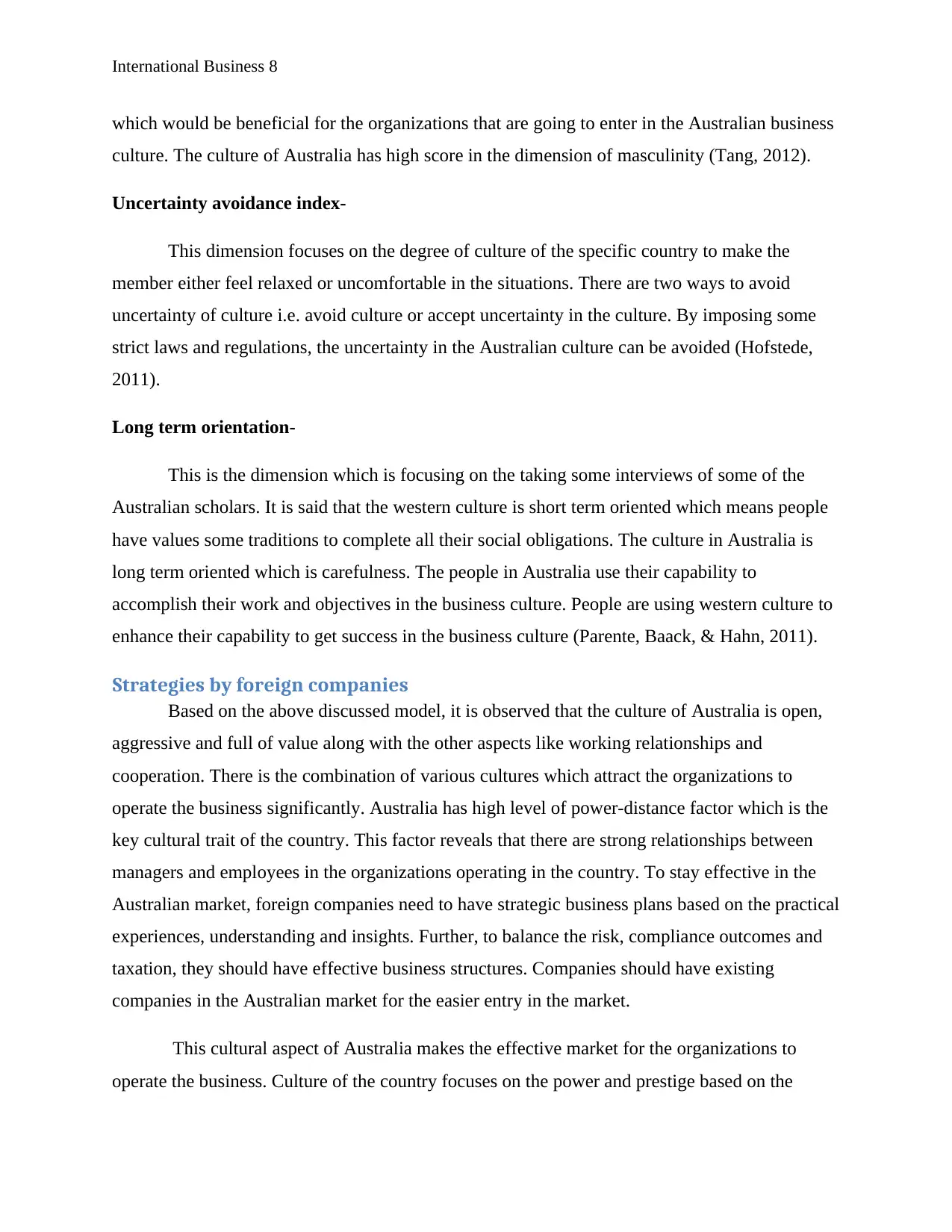
International Business 8
which would be beneficial for the organizations that are going to enter in the Australian business
culture. The culture of Australia has high score in the dimension of masculinity (Tang, 2012).
Uncertainty avoidance index-
This dimension focuses on the degree of culture of the specific country to make the
member either feel relaxed or uncomfortable in the situations. There are two ways to avoid
uncertainty of culture i.e. avoid culture or accept uncertainty in the culture. By imposing some
strict laws and regulations, the uncertainty in the Australian culture can be avoided (Hofstede,
2011).
Long term orientation-
This is the dimension which is focusing on the taking some interviews of some of the
Australian scholars. It is said that the western culture is short term oriented which means people
have values some traditions to complete all their social obligations. The culture in Australia is
long term oriented which is carefulness. The people in Australia use their capability to
accomplish their work and objectives in the business culture. People are using western culture to
enhance their capability to get success in the business culture (Parente, Baack, & Hahn, 2011).
Strategies by foreign companies
Based on the above discussed model, it is observed that the culture of Australia is open,
aggressive and full of value along with the other aspects like working relationships and
cooperation. There is the combination of various cultures which attract the organizations to
operate the business significantly. Australia has high level of power-distance factor which is the
key cultural trait of the country. This factor reveals that there are strong relationships between
managers and employees in the organizations operating in the country. To stay effective in the
Australian market, foreign companies need to have strategic business plans based on the practical
experiences, understanding and insights. Further, to balance the risk, compliance outcomes and
taxation, they should have effective business structures. Companies should have existing
companies in the Australian market for the easier entry in the market.
This cultural aspect of Australia makes the effective market for the organizations to
operate the business. Culture of the country focuses on the power and prestige based on the
which would be beneficial for the organizations that are going to enter in the Australian business
culture. The culture of Australia has high score in the dimension of masculinity (Tang, 2012).
Uncertainty avoidance index-
This dimension focuses on the degree of culture of the specific country to make the
member either feel relaxed or uncomfortable in the situations. There are two ways to avoid
uncertainty of culture i.e. avoid culture or accept uncertainty in the culture. By imposing some
strict laws and regulations, the uncertainty in the Australian culture can be avoided (Hofstede,
2011).
Long term orientation-
This is the dimension which is focusing on the taking some interviews of some of the
Australian scholars. It is said that the western culture is short term oriented which means people
have values some traditions to complete all their social obligations. The culture in Australia is
long term oriented which is carefulness. The people in Australia use their capability to
accomplish their work and objectives in the business culture. People are using western culture to
enhance their capability to get success in the business culture (Parente, Baack, & Hahn, 2011).
Strategies by foreign companies
Based on the above discussed model, it is observed that the culture of Australia is open,
aggressive and full of value along with the other aspects like working relationships and
cooperation. There is the combination of various cultures which attract the organizations to
operate the business significantly. Australia has high level of power-distance factor which is the
key cultural trait of the country. This factor reveals that there are strong relationships between
managers and employees in the organizations operating in the country. To stay effective in the
Australian market, foreign companies need to have strategic business plans based on the practical
experiences, understanding and insights. Further, to balance the risk, compliance outcomes and
taxation, they should have effective business structures. Companies should have existing
companies in the Australian market for the easier entry in the market.
This cultural aspect of Australia makes the effective market for the organizations to
operate the business. Culture of the country focuses on the power and prestige based on the
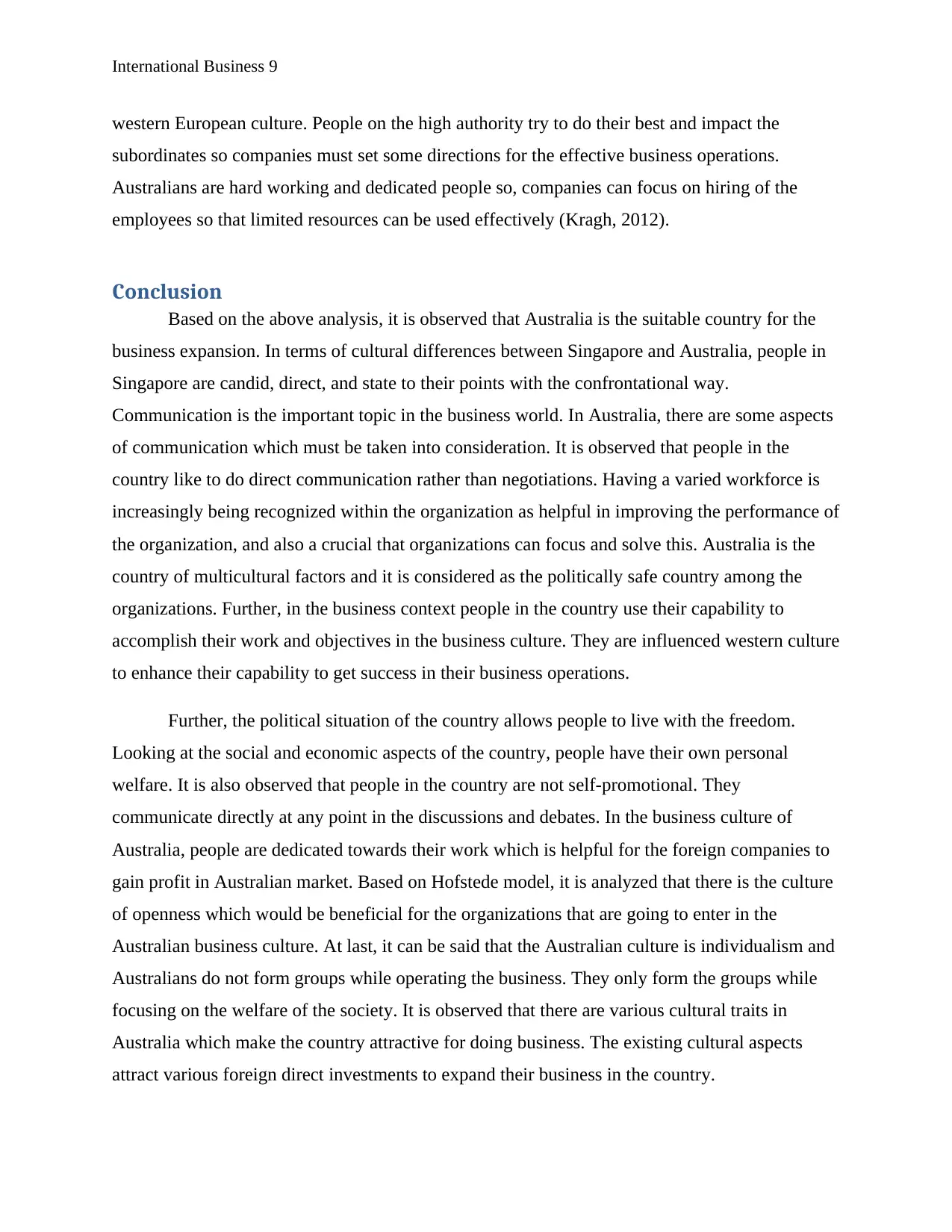
International Business 9
western European culture. People on the high authority try to do their best and impact the
subordinates so companies must set some directions for the effective business operations.
Australians are hard working and dedicated people so, companies can focus on hiring of the
employees so that limited resources can be used effectively (Kragh, 2012).
Conclusion
Based on the above analysis, it is observed that Australia is the suitable country for the
business expansion. In terms of cultural differences between Singapore and Australia, people in
Singapore are candid, direct, and state to their points with the confrontational way.
Communication is the important topic in the business world. In Australia, there are some aspects
of communication which must be taken into consideration. It is observed that people in the
country like to do direct communication rather than negotiations. Having a varied workforce is
increasingly being recognized within the organization as helpful in improving the performance of
the organization, and also a crucial that organizations can focus and solve this. Australia is the
country of multicultural factors and it is considered as the politically safe country among the
organizations. Further, in the business context people in the country use their capability to
accomplish their work and objectives in the business culture. They are influenced western culture
to enhance their capability to get success in their business operations.
Further, the political situation of the country allows people to live with the freedom.
Looking at the social and economic aspects of the country, people have their own personal
welfare. It is also observed that people in the country are not self-promotional. They
communicate directly at any point in the discussions and debates. In the business culture of
Australia, people are dedicated towards their work which is helpful for the foreign companies to
gain profit in Australian market. Based on Hofstede model, it is analyzed that there is the culture
of openness which would be beneficial for the organizations that are going to enter in the
Australian business culture. At last, it can be said that the Australian culture is individualism and
Australians do not form groups while operating the business. They only form the groups while
focusing on the welfare of the society. It is observed that there are various cultural traits in
Australia which make the country attractive for doing business. The existing cultural aspects
attract various foreign direct investments to expand their business in the country.
western European culture. People on the high authority try to do their best and impact the
subordinates so companies must set some directions for the effective business operations.
Australians are hard working and dedicated people so, companies can focus on hiring of the
employees so that limited resources can be used effectively (Kragh, 2012).
Conclusion
Based on the above analysis, it is observed that Australia is the suitable country for the
business expansion. In terms of cultural differences between Singapore and Australia, people in
Singapore are candid, direct, and state to their points with the confrontational way.
Communication is the important topic in the business world. In Australia, there are some aspects
of communication which must be taken into consideration. It is observed that people in the
country like to do direct communication rather than negotiations. Having a varied workforce is
increasingly being recognized within the organization as helpful in improving the performance of
the organization, and also a crucial that organizations can focus and solve this. Australia is the
country of multicultural factors and it is considered as the politically safe country among the
organizations. Further, in the business context people in the country use their capability to
accomplish their work and objectives in the business culture. They are influenced western culture
to enhance their capability to get success in their business operations.
Further, the political situation of the country allows people to live with the freedom.
Looking at the social and economic aspects of the country, people have their own personal
welfare. It is also observed that people in the country are not self-promotional. They
communicate directly at any point in the discussions and debates. In the business culture of
Australia, people are dedicated towards their work which is helpful for the foreign companies to
gain profit in Australian market. Based on Hofstede model, it is analyzed that there is the culture
of openness which would be beneficial for the organizations that are going to enter in the
Australian business culture. At last, it can be said that the Australian culture is individualism and
Australians do not form groups while operating the business. They only form the groups while
focusing on the welfare of the society. It is observed that there are various cultural traits in
Australia which make the country attractive for doing business. The existing cultural aspects
attract various foreign direct investments to expand their business in the country.
⊘ This is a preview!⊘
Do you want full access?
Subscribe today to unlock all pages.

Trusted by 1+ million students worldwide
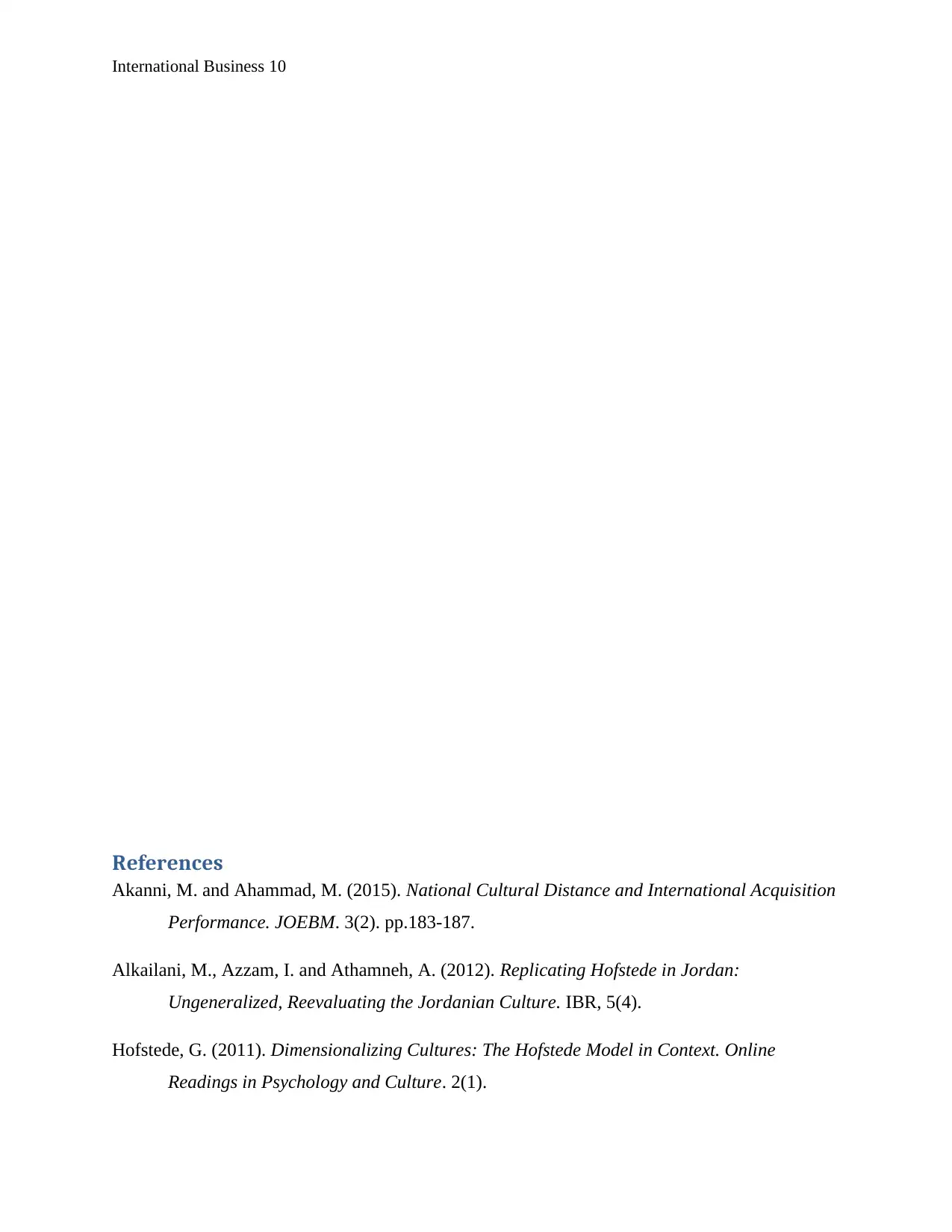
International Business 10
References
Akanni, M. and Ahammad, M. (2015). National Cultural Distance and International Acquisition
Performance. JOEBM. 3(2). pp.183-187.
Alkailani, M., Azzam, I. and Athamneh, A. (2012). Replicating Hofstede in Jordan:
Ungeneralized, Reevaluating the Jordanian Culture. IBR, 5(4).
Hofstede, G. (2011). Dimensionalizing Cultures: The Hofstede Model in Context. Online
Readings in Psychology and Culture. 2(1).
References
Akanni, M. and Ahammad, M. (2015). National Cultural Distance and International Acquisition
Performance. JOEBM. 3(2). pp.183-187.
Alkailani, M., Azzam, I. and Athamneh, A. (2012). Replicating Hofstede in Jordan:
Ungeneralized, Reevaluating the Jordanian Culture. IBR, 5(4).
Hofstede, G. (2011). Dimensionalizing Cultures: The Hofstede Model in Context. Online
Readings in Psychology and Culture. 2(1).
Paraphrase This Document
Need a fresh take? Get an instant paraphrase of this document with our AI Paraphraser
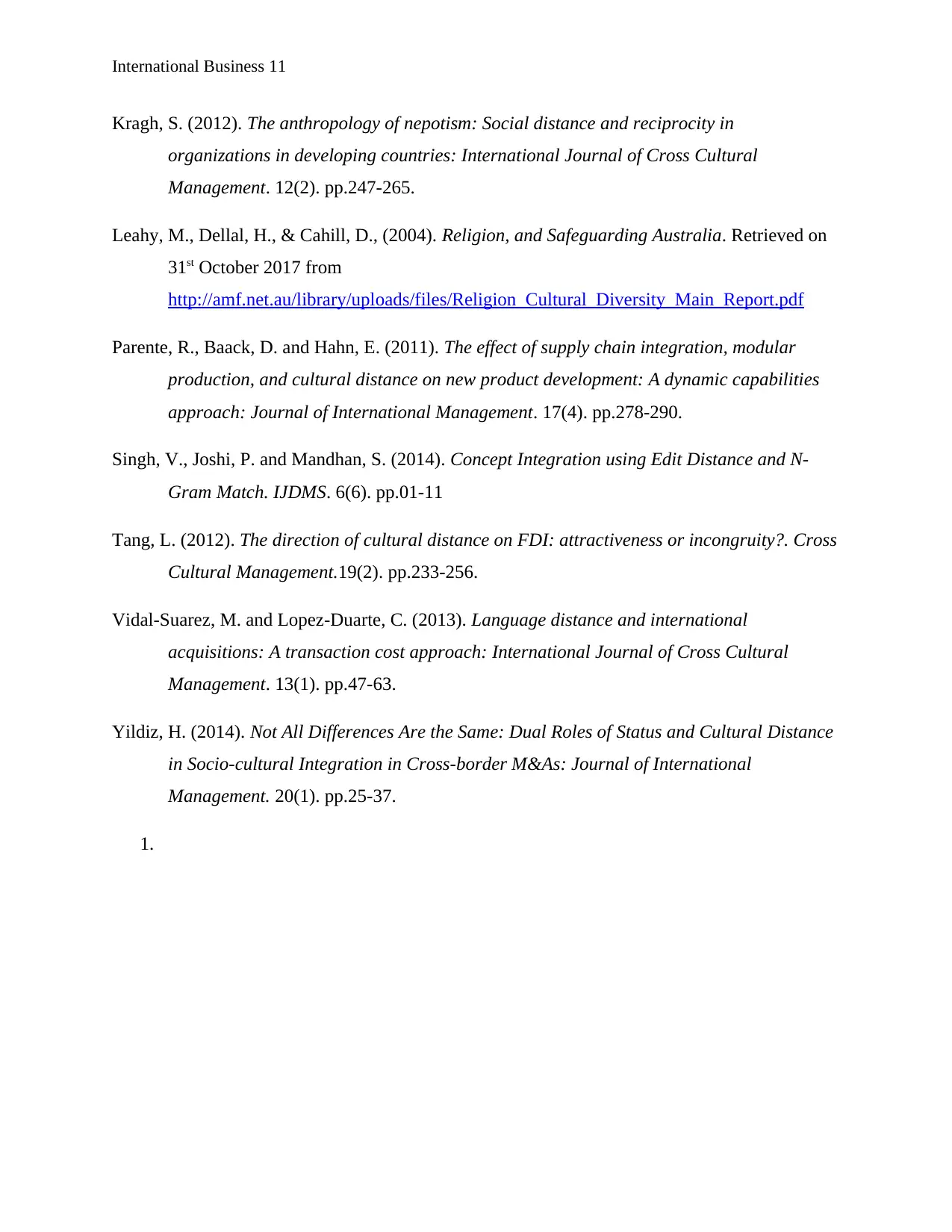
International Business 11
Kragh, S. (2012). The anthropology of nepotism: Social distance and reciprocity in
organizations in developing countries: International Journal of Cross Cultural
Management. 12(2). pp.247-265.
Leahy, M., Dellal, H., & Cahill, D., (2004). Religion, and Safeguarding Australia. Retrieved on
31st October 2017 from
http://amf.net.au/library/uploads/files/Religion_Cultural_Diversity_Main_Report.pdf
Parente, R., Baack, D. and Hahn, E. (2011). The effect of supply chain integration, modular
production, and cultural distance on new product development: A dynamic capabilities
approach: Journal of International Management. 17(4). pp.278-290.
Singh, V., Joshi, P. and Mandhan, S. (2014). Concept Integration using Edit Distance and N-
Gram Match. IJDMS. 6(6). pp.01-11
Tang, L. (2012). The direction of cultural distance on FDI: attractiveness or incongruity?. Cross
Cultural Management.19(2). pp.233-256.
Vidal-Suarez, M. and Lopez-Duarte, C. (2013). Language distance and international
acquisitions: A transaction cost approach: International Journal of Cross Cultural
Management. 13(1). pp.47-63.
Yildiz, H. (2014). Not All Differences Are the Same: Dual Roles of Status and Cultural Distance
in Socio-cultural Integration in Cross-border M&As: Journal of International
Management. 20(1). pp.25-37.
1.
Kragh, S. (2012). The anthropology of nepotism: Social distance and reciprocity in
organizations in developing countries: International Journal of Cross Cultural
Management. 12(2). pp.247-265.
Leahy, M., Dellal, H., & Cahill, D., (2004). Religion, and Safeguarding Australia. Retrieved on
31st October 2017 from
http://amf.net.au/library/uploads/files/Religion_Cultural_Diversity_Main_Report.pdf
Parente, R., Baack, D. and Hahn, E. (2011). The effect of supply chain integration, modular
production, and cultural distance on new product development: A dynamic capabilities
approach: Journal of International Management. 17(4). pp.278-290.
Singh, V., Joshi, P. and Mandhan, S. (2014). Concept Integration using Edit Distance and N-
Gram Match. IJDMS. 6(6). pp.01-11
Tang, L. (2012). The direction of cultural distance on FDI: attractiveness or incongruity?. Cross
Cultural Management.19(2). pp.233-256.
Vidal-Suarez, M. and Lopez-Duarte, C. (2013). Language distance and international
acquisitions: A transaction cost approach: International Journal of Cross Cultural
Management. 13(1). pp.47-63.
Yildiz, H. (2014). Not All Differences Are the Same: Dual Roles of Status and Cultural Distance
in Socio-cultural Integration in Cross-border M&As: Journal of International
Management. 20(1). pp.25-37.
1.
1 out of 11
Related Documents
Your All-in-One AI-Powered Toolkit for Academic Success.
+13062052269
info@desklib.com
Available 24*7 on WhatsApp / Email
![[object Object]](/_next/static/media/star-bottom.7253800d.svg)
Unlock your academic potential
Copyright © 2020–2025 A2Z Services. All Rights Reserved. Developed and managed by ZUCOL.





